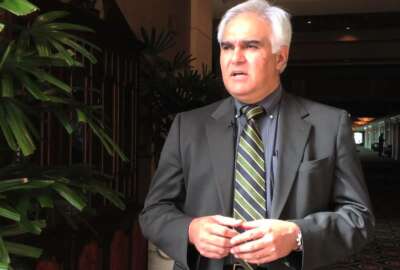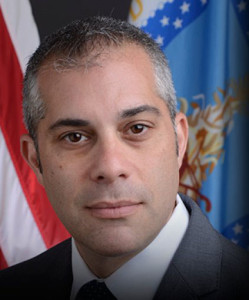

Jonathan Alboum, the Agriculture Department’s chief information officer, is being transferred to the deputy senior procurement executive role.
The next shoe in the Trump administration’s plan to change out many career federal chief information officers dropped this week.
Sources confirm Jonathan Alboum, the Agriculture Department’s chief information officer, has been reassigned.

Sources say USDA is transferring Alboum to be the deputy senior procurement executive. Alboum has been USDA CIO since June 2015.
USDA’s decision to transition Alboum is part of a major management reorganization, which also includes Deputy Assistant Secretary for Management Malcolm Shorter and possibly others in the CXO community.
Additionally, USDA’s move follows that of the Treasury Department, which moved its CIO, Sonny Bhagowalia, to the Bureau of Fiscal Service in July.
Sources say Alboum and Bhagowalia are being moved because they are seen as being too close or too friendly to the Obama administration.
“This is unfortunate, ridiculous and absurd as these are career employees,” said one industry source, who requested anonymity in order to talk about personnel changes. “These guys have done nothing wrong. All these guys have done is do their jobs and they have done them well so to be penalized is wrong. Political CIOs understand they will leave at end of administration. But for career CIOs, this isn’t fair.”
A source said USDA didn’t name an acting CIO even on an interim basis.
An Office of Management and Budget spokesman said the agency had nothing to share at this time.
A USDA spokesman said in an email to Federal News Radio that since these Senior Executive Service movements are still pending, and since they are personnel matters, they cannot comment on individual employee cases.
“Since taking office, Secretary [Sonny] Perdue has been impressed with the professionalism and dedication of the career staff at USDA and believes it is the finest in all of the federal government. He also believes that the strength of USDA lies in its people, so in his continuing efforts to make USDA the most effective, most efficient, and best managed department in the U.S. government, he is seeking to match people with the most appropriate positions,” the USDA spokesman wrote. “As a result, a number of members of the Senior Executive Service at USDA were offered the opportunity for reassignment to new roles within USDA. This is in keeping with the goals of the SES as established in 1978 to create a cadre of leaders whose skills are transferable to numerous areas of government. These valued USDA employees fit the description of SES leaders, as defined by the Office of Personnel Management, as people who possess well-honed executive skills and share a broad perspective on government and a public service commitment.”
Another source said every new administration looks at their career SES members and decides where they fit best. But the source said it’s difficult to determine if an executive is committed to one administration over another.
The decision to move Alboum to a procurement management role is not totally off base. Alboum worked at the General Services Administration’s Federal Acquisition Service as its deputy CIO. And earlier in his career, he worked as a management consultant for both PricewaterhouseCoopers and Ventera Corporation where he managed several large system implementations.
But nearly every other job has been in technology or technology management, such as program executive for USDA’s Modernize and Innovate the Delivery of Agriculture Services (MIDAS) system and GSA’s associate CIO for enterprise governance and planning. So moving him into an acquisition heavy role is not necessarily a logical or clearly understood decision.
The USDA spokesman said the agency rejects the assumption that the “employees in question are unqualified for the positions they may move into.”
During his tenure as CIO, Alboum has been pushing to consolidate 17 disparate networks and modernize USDA technology infrastructure through the recently awarded Enterprise Infrastructure Solutions (EIS) contract.
Alboum also set up a dedicated team to implement the Federal IT Acquisition Reform Act (FITARA) and address acquisition, investment oversight and workforce plans.
He also established a director of cloud strategy and policy position, who works across the agency to move mission areas into the cloud and ensure other cloud-related priorities such as security are addressed in a holistic manner.
Once source said USDA and Treasury’s decisions to move their CIOs is part of a governmentwide effort to bring in different technology executives—ones that are focused on the business or mission side and less on technology.
Alboum’s efforts were not focused on any Obama-centric initiative, but on the technology transformation wave happening across the public and private sectors, and this is why sources were surprised by USDA’s decision to transfer him to a new role.
“My understanding is this is being pushed by a couple of people in the White House, possibly in presidential personnel and other people who came through the Trump campaign and are deciding to get rid of anyone who may be perceived as loyal to Obama, because they believe these career feds will not do what they want them to do,” the source said. “As far as I’ve heard, this isn’t coming from Chris Liddell [director of Strategic Initiatives and director of the American Technology Council] or Reed Cordish [special assistant to the president for intragovernmental and technology initiatives]. I think what’s happening in my view is because they do want to do some positive things around modernizing federal technology, they don’t want anyone who they perceive would undermine or drag their feet. That’s my interpretation of what’s going on.”
Changes to USDA and Treasury bookend a busy few weeks of changes in the federal CIO community.
Department of Navy CIO Rob Foster announced he’s becoming the deputy CIO at the National Credit Union Administration.
Dave DeVries, the CIO at OPM, resigned as of Sept. 2.
Sources say it’s unclear whether Foster and DeVries are part of the Trump administration’s plan to replace career federal CIOs.
But sources did say that anyone considering a position with the administration should be aware of the questions being asked of potential political appointees:
Additionally, anyone considering or currently in a federal technology position should be sure to communicate in a way that helps the Trump administration achieve their mission.
A source said too often CIOs talk about compliance with the Federal IT Acquisition Reform Act (FITARA) or the Federal Information Security Management Act (FISMA) before they talk about the need to modernize and transform federal services.
Copyright © 2024 Federal News Network. All rights reserved. This website is not intended for users located within the European Economic Area.
Jason Miller is executive editor of Federal News Network and directs news coverage on the people, policy and programs of the federal government.
Follow @jmillerWFED

